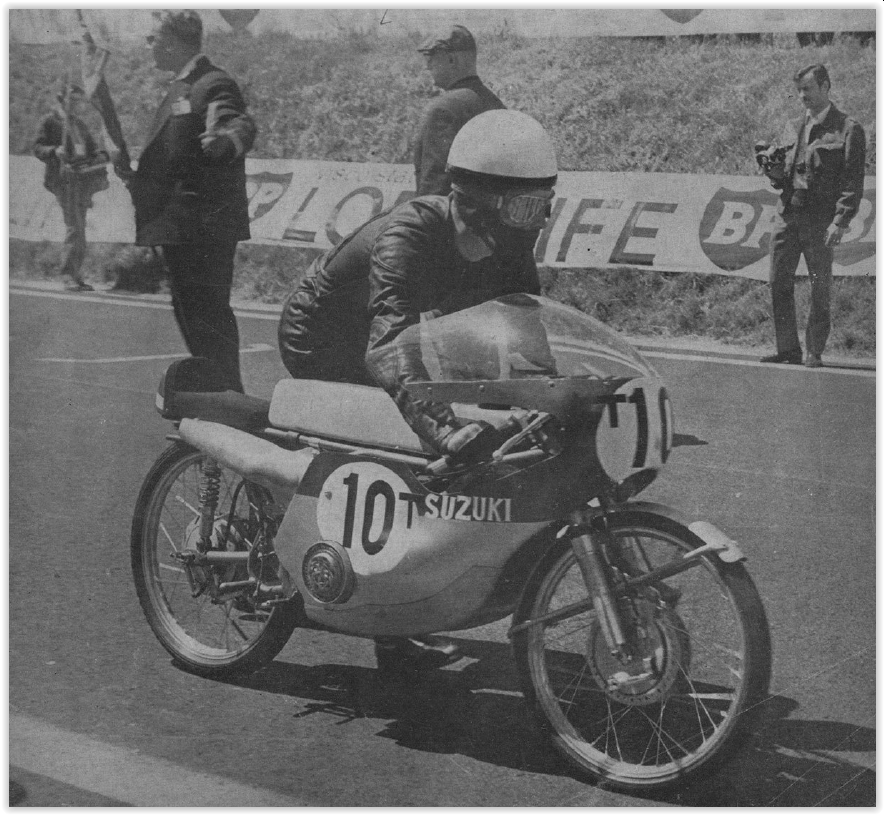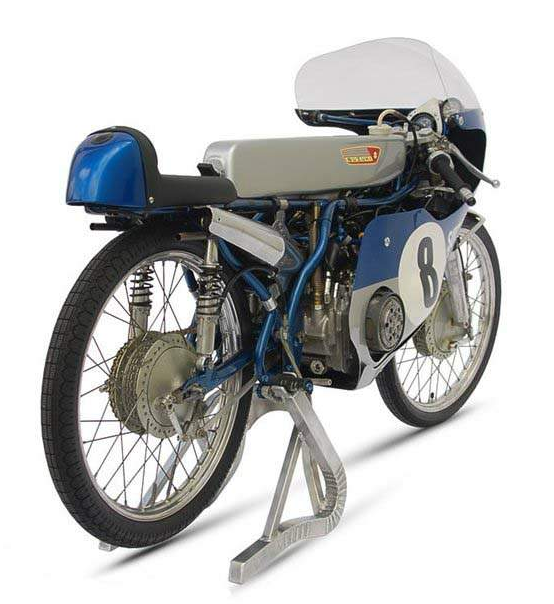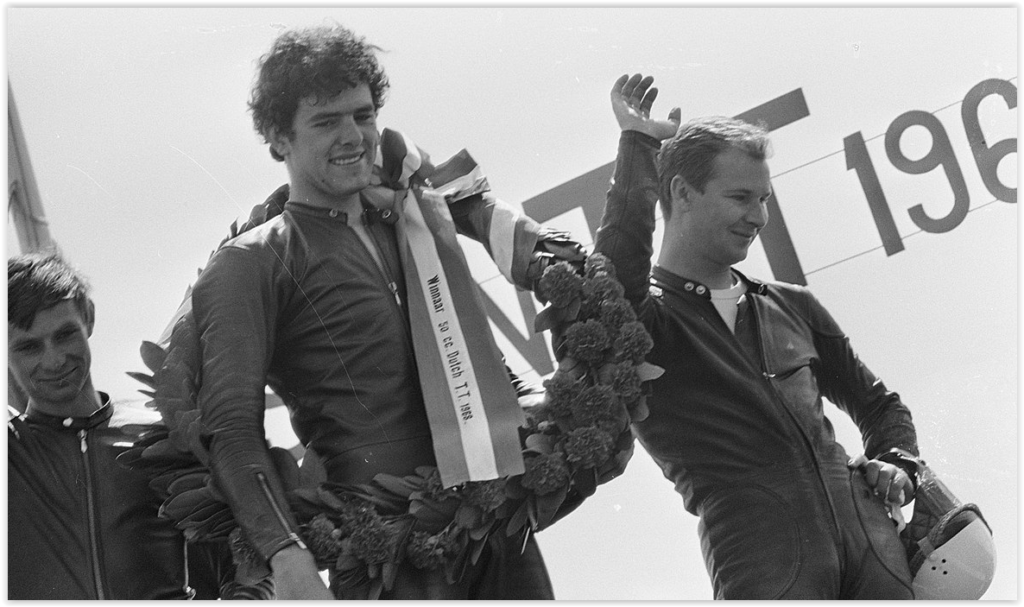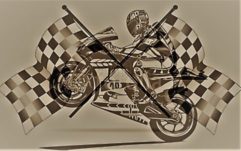
The unexpected 1968 season as a private driver
At the season finale in Japan, Suzuki had a secret project in the box last year. Those responsible managed to shield the new engine from curious photographers. It was a 50-series engine with a design like a square 4-cylinder engine, but with one cylinder “missing”. It has already been used in training for the 1967 Japanese GP. After the driver and manufacturer world championship title was already in the towel before the race, the new 3-cylinder engine was dispensed with for the race. It was decided to use the tried and tested 2-cylinder engine. For the 1968 season, Hans Georg Anscheidt was scheduled for the third season as a Suzuki works driver, together with Yoshimi Kagayama. The Japanese competed successfully as a works-driver last year. He won 2 Grand Prix and was 50cc Vice World Champion behind Anscheidt.

The shock
Even before the start of the 1968 season, news from the end of February shocked the sports world. Honda withdrew from the competition after seven GP seasons! After 138 wins in the five solo classes, 16 drivers ‘titles and 18 manufacturers’ titles, this decision came as a surprise to many. The reason for this was the announcement by the highest motorcycle sports authority FIM that it would introduce serious technical restrictions in 1969.

Drastic changes in the technical regulations led to the withdrawal
Due to the announced regulations, the 4, 5 and 6-cylinder engines of the middle classes developed by the Japanese were banned in 1969. Just like the engines with more than one cylinder in the 50cc, and more than 6 gears. There was also a restriction to 2-cylinder engines in the 125cc class. In this category, Suzuki competed with a V4-cylinder two-stroke against Honda with an in-line five-cylinder four-stroke in the 1967 season. The 50cc series 2-cylinder from Suzuki of 1968 had 14 gears. This was necessary in order to be able to use the narrow speed range at which the engine delivered sufficient power.

Logical reasons to withdraw
Honda had long been the world market leader for motorcycles in 1968 and wanted to get into Formula 1 from now on in order to promote sales in the automotive division. The Japanese plants of Honda and Suzuki certainly felt offended by the announcement by the FIM. The gigantic effort that had been made so far made hardly any sense for just one more season. The two former Honda factory drivers Hailwood and Bryans received machines and spare parts for 1968. But only for races outside the World Cup, with a clear ban on participation in Grand Prix. Before the start of the season, Suzuki also decided to withdraw, leaving only Yamaha and Kawasaki as Japanese plants in the World Cup. The European H. G. Anscheidt and Stuart Graham (GBR) intended as factory drivers received 50 and 125 cm³ machines from the factory and a stock of spare parts to organize themselves. Only Hans Georg Anscheidt then decided to take part in the world championship as a private driver, with a German mechanic. Suzuki also contributed a pickup truck for it.

Works teams in the 1968 motorcycle world championship
Kawasaki had previously only been a small team and otherwise only Yamaha remained as the Japanese manufacturer, while Honda and Suzuki, the two most successful manufacturers from Japan, had withdrawn with immediate effect. Both of them came back, but this would take quite a while.

The 1968 rump season for the 50cc World Championship
With just 5 races, the 1968 season was downright a rump season, while 12 laps were planned for the remaining categories. After the cancellation of two Grand Prix, the championship from 1968 was ultimately reduced to ten. There were 9 rounds in the 125cc category and 7 in the 350cc category. Only up to 250cc and for the 500cc premier class there were 10 championship races. The 1967 Canadian Grand Prix was an isolated case and never continued.

Perfect start to the new season
Things couldn’t go much better for the semiprivate driver H. G. Anscheidt than at the season opener at the home GP on the Nürburgring-Südschleife. The German won the 50cc race ahead of his compatriots Rudolf Kunz and Rudolf Schmälzle (both on Kreidler). In the 125cc class, he only had to bow to Yamaha works rider Phil Read. His compatriot Siegfried Möhringer took an excellent third place on Neckermann-MZ. The department store chain had decided to sell the East German brand MZ from Zschopau in Saxony. For this reason, an actual works team was put into the World Cup. However, the technical support from the MZ factory in the GDR was limited and often gave rise to complaints.



Another win in round 2 at the Spanish GP
On the Montjuic Park route near Barcelona, the second 50cc victory in a row confirmed the result of the season opener in Germany. Anscheidt won ahead of the two Derbi pilots Angel Nieto (SPA) and Barry Smith (AUS). The foundation stone for the hat trick with 3 world championship titles in a row was laid. We continued on the so-called Mountain Course on the Isle of Man with the TT, which was part of the World Cup at the time. But even before leaving for the race in Northern Ireland, things were far from optimal for Hans Georg.



Scandal even before the TT race
Since only the 3 best results of a driver counted towards the world championship, he could have secured the third world championship title in a row in the 3rd round by winning the Tourist Trophy. But it shouldn’t be, the organizers only offered the 2-time world champion a ridiculous entry fee of 50 pounds, a veritable scandal. He would not even have covered half of his travel expenses. Therefore, with a heavy heart, he decided not to travel and the German media reported critically about the arrogant and incomprehensible behavior of the organizers. At least Hans Georg was able to comfort himself with the fact that he could already close the bag in the next round at the Dutch TT in Assen in order to secure the title early.

The exciting race of Assen
A podium placement should be enough to secure the 3rd title in a row after only 4 of only 5 rounds of the 50cc World Championship. After the start of the Assen GP, initially only in 4th position, at the end of the first lap Hans Georg managed to take the lead from the Dutchman Paul Lodewijkx. In front of around 150,000 spectators, the Dutch TT was, as so often in previous years, a real folk festival.

In the country that is known today, among other things, for its residents who love to travel with their caravans and campers, the pilots of the “shot glass class” have always been taken for full. And now there was frenetic jubilation in the first race of the day when the local hero just couldn’t be shaken off by Anscheidt. Lodewijkx, who raced on a water-cooled single cylinder Jamathi built by friends, drove the race of his life. At the beginning there was even a chasing group of several people close behind the two, but from the 4th lap they shrank to three drivers and were around 200 meters behind the lead.

The surprising winner
Anscheidt started the eighth and final lap with a lead of around 40 meters over Lodewijkx. Shortly before the finish, the two-time world champion ran into a bunch of drivers to be lapped. This was the chance for his pursuer and local hero. When Hans Georg started to stand up behind his disguise before the finish line, his opponent shot past him by a hair’s breadth. The Dutchman sensationally won his first Grand Prix with a lead of a tenth of a second over Anscheidt. The Kreidler drivers Aalt Toersen, Jan de Vries, Jos Schurgers (all Netherlands) and the German Rudolf Schmälzle completed the top 6 and thus the points. Rudolf Kunz (Germany, Kreidler) finished eighth in this race. Paul Lodewijkx was the first Dutchman to win his home Grand Prix. The following year he suffered serious injuries in a motorbike accident. Three years later he tried unsuccessfully to resume his racing career.


The third world title – as a private driver

Before the final round – the World Cup was decided
Even if Lodewijkx or the Australian TT winner Barry Smith won, Hans Georg Anscheidt’s hat trick was already clear before the final in Spa-Francorchamps. With two wins and second place in Assen, the third world title in a row had become a fact. Despite the fact that the works team had withdrawn before the start of the season, Suzuki had already won the manufacturers’ championship in the 50cc class. Only a week later they went to Belgium, where on July 7, 1968, the fifth and final round of the 50cc World Championship took place.

Belgian GP – third win of the season for the three-time world champion
The fast track from Spa-Francorchamps was already a good place for the newly crowned 3-time world champion last year. Back then he had won ahead of his teammates from last year, Yoshimi Katayama and Stuart Graham, and Angel Nieto had finished fourth. Already during training, Hans Georg indicated with the best time that victory at the Belgian GP could only be achieved through him. Immediately after the start he took the lead and after the first lap he crossed the finish line with a 20-second lead over Lodewijkx as the first pursuer.

A pointless assumption turned out to be wrong
After the Grand Prix, which only lasted 5 laps and a distance of 70.5 km (43.8 miles), Anscheidt saw the checkered flag over a minute before the runner-up. Paul Lodewijkx was second world champion with rank 2. Third place went to Angel Nieto ahead of Barry Smith (both Derbi), Martin Mijwaart (NED) and Rudolf Smälzle (GER). The latter was seventh in the overall ranking of the World Cup, two places behind his compatriot Rudolf Kunz. Angel Nieto had protested against the Jamathi von Lodewijkx after the race because he had suspected that the engine had been cheated. His teammate Smith had advised against it before and the Spaniard was promptly wrong in his allegation. The Jamathi was measured at exactly 49.6cc.


50cc World Championship final score – Anscheidts title No. 3
For the World Championship only the best 3 results in 5 World Championship rounds counted. After only the first 6 drivers of a race were able to win world championship points at that time, here for the sake of completeness also the drivers who finished 7th to 10th in a GP:
Jan Bruins (NL, Kreidler), Jacques De Ara (F, Derbi), Herbert Denzler (CH, Kreidler), Peter Eser (GER, Honda), Benjamin Grau (E, Derbi), John Lawley (GB, Honda), Yves Le Toumelin (F, Derbi), José Maner (E, Derbi), N. Mayo (GB, Heldun), André Millard (F, Derbi), Jaap Moojen † (NL, Kreidler), Juan Parés (E, Derbi), Fran Redfern (GB, Honda), Winfried Reinhard (GER, Kreidler), R. Stopford (GB, Heldun), J. van Leeuwen (NL, Honda).

World Championship final result 125cc in 1968
After finishing 2nd at the season opener in Hockenheim, H. G. Anscheidt secured another podium with 3rd place at the season finale in Monza. This was enough for 8th place in the World Championship behind his compatriot Dieter Braun. Heinz Rosner, who came from the former GDR, was the best German, with 3 third places it was enough for him to place 4 in the world championship. The title went to Phil Read, ahead of Bill Ivy (both England) and Ginger Molloy (New Zealand). For the sake of completeness, here are also the drivers who finished 7th to 10th at a GP, as only the first 6 championship points received (as opposed to the first 15 today):
Juan Bordons (E, Bultaco), Ruud Breedt (NL, Honda), Jim Curry (GB, Honda), Gary Dickinson (GB, Honda), John Kiddie (GB, Honda), Ingo Koppe (GDR, MZ), Heinz Kriwanek (A, Rotax), David Lloyd (CDN, Honda), Eberhard Mahler (GDR, MZ), Ryszard Mankiewicz (PL, MZ), Michael McGarrity (N.Irl., Honda), Angel Nieto (E, Derbi), George Plenderleith (GB, Honda), Rolf Schmid † (GER, Honda), Horst Seel (GER, Bultaco), John Shacklady (GB, Bultaco), G. Sigura (H, MZ), Barry Smith (AUS, Derbi), Brian Smith (AUS, Honda), Francesco Villa (I, Villa).

Grand Prix milestones from Hans Georg

We owe a great deal to H. G. Anscheidt
We owe a lot to the German. We only list two important reasons here, even if there are definitely many more for them. First, Hans Georg Anscheidt rescued some machines from Suzuki’s inventory that would otherwise have been destroyed. The mentality of the Japanese from the Hamamatsu plant was very different from that of Europe, as Anscheidt put on record at the time. Normally, for reasons of space, Suzuki always scrapped all the factory machines and the spare parts at the end of the year. Second, he was a role model for countless adolescents, with his own column in the youth magazine “Bravo”, which is still known today.

Resignation at the right time – at the height of success
With his friendly and open-minded, always humble nature, he made a huge contribution to motorsport, especially in Germany. At the end of the 1968 season, Hans Georg Anscheidt retired from racing. Only the Bavarian Toni Mang was able to surpass Anscheidt’s successes from 1981 to 1987 when he secured a total of 5 world titles. Together with Werner Haas, the three-time world champion from Prussia is still the second best German GP driver on two wheels of all time.

The successes of H. G. Anscheidt in brief
German 50 cm³ champion: 1962, 1963, 1964, 1965, 1966, 1967, 1968
German 125 cm³ champion: 1966, 1967
1961 – 50 cm³ European champion on Kreidler
1962 – 50 cm³ vice world champion on Kreidler
1963 – 50 cm³ vice world champion on Kreidler
1964 – 50 cm³ World Cup third on Kreidler
1966 – 50 cm³ world champion on Suzuki
1967 – 50 cm³ world champion on Suzuki
1968 – 50 cm³ world champion on Suzuki
14 Grand Prix victories (despite sometimes only 5 or 6 World Championship rounds per year)


No Comments Yet